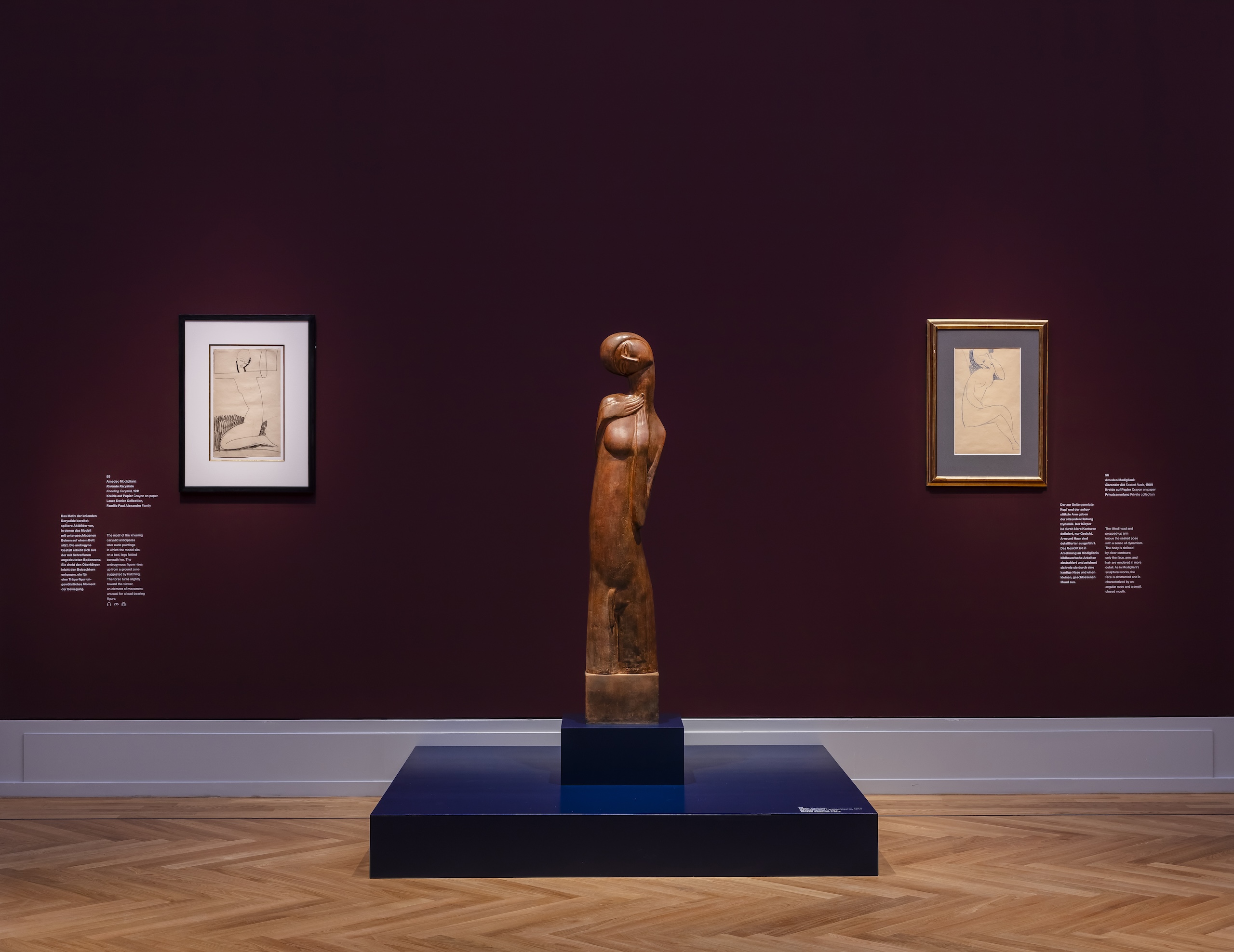
Modigliani: Modern Gazes, on view through August 18th at the Museum Barberini in Potsdam, focuses on the legacy of Amedeo Modigliani, a decisively European artist whose work resonated not just with his compatriots in Paris but among his contemporaries across the continent. With loans from institutions including the Centre Pompidou, the Metropolitan Museum of Art, and the Tate London, Modern Gazes pairs 56 of Modigliani’s Paris works from 1907 to 1919 with simpatico pieces of the period by artists like Egon Schiele, Wilhelm Lehmbruck, Paula Modersohn-Becker, and Gustav Klimt.

Johanna Staude, 1917–18
Oil on canvas, 70 x 50 cm
Belvedere, Vienna
© akg-images / Erich Lessing
The broad strokes of the School of Paris painter and sculpture Amedeo Modigliani’s biography are usually consistent — the French-Italian, Jewish, but not religious artist from Livorno was an indelible member of the creative scene that flourished in Paris’s Montmartre and Montparnasse districts during the early 20th century. Inspired by more established artists like Pablo Picasso, he was a product of this environment, but he also exerted his own influence on the scene, not least of all through his countercultural excesses as an alcoholic and drug-addicted bon vivant.
In broadening the view of Modigliani to a European rather than only a School of Paris artist, Museum Barberini’s Modigliani: Modern Gazes begins by plumbking his inspirations outside the city. During his first eight years in Paris, when he primarily worked as a sculptor, Modigliani looked to Greek caryatids, the Louvre’s Egyptian collection, and the global cultures he studied at the Musée d’Ethnographie du Trocadéro. The work he produced was quickly reflected back at him by other Parisian artists; Ossip Zadkin’s 1914 bronze sculpture, Hermaphrodite, pairs nicely with Modigliani’s Seated Nude, a study he made in 1909.
The show also repositions Modigliani as a chronicler of emancipated women. His first and only solo show, in 1917 at Galerie Berthe Weil, caused a scandal thanks to his many depictions of casually lounging nudes, several of which are shown here, including Reclining Nude on a White Cushion and Reclining Nude (On the Left Side).

Reclining Nude (on the Left Side), 1917
Oil on canvas, 89.5 x 146.7 cm
Nahmad Collection
Modern Gazes also devotes an entire room to Modigliani’s portraits of his self-assured circle of women writers, artists, and designers, like Elena Povolozky and Renée Kisling, who, with short hair and often wearing men’s clothing, seemed to anticipate the coming era of the femme garçonne, an artistic trope key to the New Objectivity painting of the 1920s. What Modern Gazes suggests is that the solo show at Weil’s gallery didn’t cause offense because of its nudity, which was hardly unfamiliar in French painting in 1917, but the independent demeanor of so many of its subjects.
Of course, the exhibition probes Modigliani’s most famous Paris connections. After finishing art school in Venice, he arrived in the city in 1906. He moved into the Bateau-Lavoir, a Montmartre squat popular with artists, around the same time as the Spanish Cubist painter Juan Gris, and they became friends. (Modigliani’s sensitive 1915 portrait of Gris is here on loan from the Metropolitan Museum of Art). He met Pablo Picasso, Chaïm Soutine, and his first patron, Paul Alexandre. When he fled south before German troops arrived in Paris in 1918, he met Pierre-Auguste Renoir, was inspired by Paul Cézanne, and his frontal portraits, while staying true to his flat, elongated style, brightened up considerably.

On a more personal level, the show also explores Modigliani’s more particular connections, through his portraits of fellow Jewish artists, like Moïse Kisling and Pinchus Krémègne, as well as addicts, like the wealthy, morphine-dependent Maud Abrantès. Viewers also come to a better understanding of his friends, through his portraits of painters Émilie Charmy, Moïse Kisling, and Kisling’s wife, Renée Gros.

Self-Portrait, 1906–07
Oil on canvas, 81 x 65 cm
Galerie Bernard Bouche, Paris
© VG Bild-Kunst, Bonn 2024 / Galerie Bernard Bouche, Paris
After looking inward to this special Parisian world, Museum Barberini’s Modern Gazes pulls work from across Europe, drawing comparisons between its subject and Gustav Klimt and August Macke in terms of light and color; in the similar angles of Egon Schiele; and in the sculptural lines of Wilhelm Lehmbruck. Despite his personal excesses and early death from tuberculosis, Modigliani was an indelible part of a bigger early 20th century picture, a new wave of viewing the human image that sprung not just from Paris, but much of the continent.
Cover photo © David von Becker
(April 2024)
Learn more about Museum Barberini.


Leave a Reply